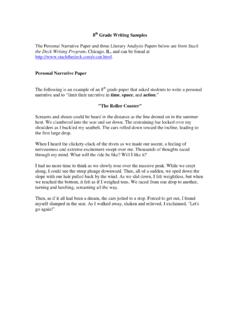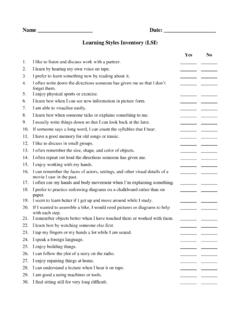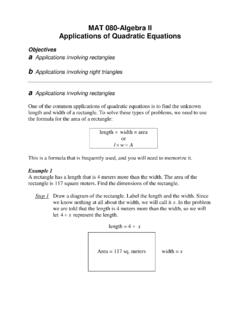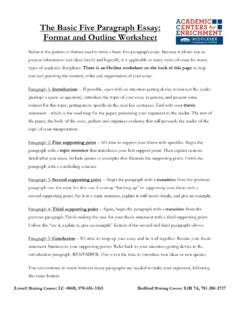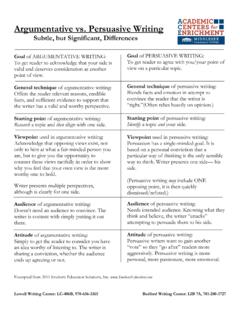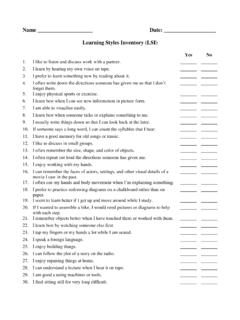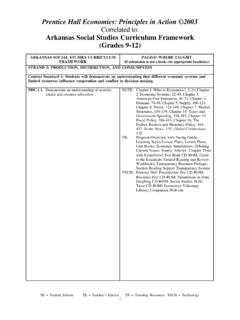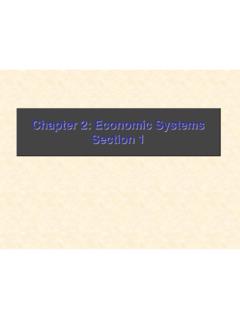Transcription of Introduction to Microeconomics
1 2014. Introduction to Microeconomics Working the Basics By Fred J. Colangelo Professor of Business and Economics middlesex community college Creative Commons public licenses provide a standard set of terms and conditions that creators and other rights holders may use to share original works of authorship and other material subject to copyright and certain other rights specified in the public license below. The following considerations are for informational purposes only, are not exhaustive, and do not form part of our licenses. You are free to: Share copy and redistribute the material in any medium or format.
2 The licensor cannot revoke these freedoms as long as you follow the license terms. Under the following terms: Attribution You MUST give appropriate credit, provide a link to the license, and indicate if changes were made. You may do so in any reasonable manner, but not in any way that suggests the licensor endorses you or your use. NonCommercial You may NOT use the material for commercial purposes. NoDerivatives If you remix, transform, or build upon the material; you may NOT. distribute the modified material. No additional restrictions You may NOT apply legal terms or technological measures that legally restrict others from doing anything the license permits.
3 | Page 1. Microeconomics is the branch of economics that analyzes the market behavior of consumers and firms in an attempt to understand the decision-making process of firms and households. Microeconomics is concerned with the interaction between individual buyers and sellers and the factors that influence the choices made by buyers and sellers. In particular, Microeconomics focuses on patterns of supply and demand and the determinations of price and output in individual markets. This textbook is an interactive workbook that will help student master the basic concepts of Microeconomics that they would encounter in a Microeconomics class.
4 The workbook consists of seven chapters where the student will be required to perform basic fundamental exercises using pencil and eraser to help them master the basic concepts of supply and demand, shifts in supply and demand, equilibrium, elasticity, externalities, public finance, tax systems, consumer choice, production and costs topics such as total and marginal revenue . Chapter 1: Supply and Demand ..2. Chapter 2: Equilibrium ..13. Chapter 3: Elasticity ..19. Chapter 4: Externalities ..22. Chapter 5: Public Finance and Choice.
5 30. Chapter 6: Consumer Choice ..35. Chapter 7: Production and Cost ..41. Page 2 |. Chapter 1 Supply & Demand In the world of economics, behaviors of buyers and sellers are important. Buyers determine the demand side of the market; they include consumers who purchase goods and services. Sellers on the other hand determine the supply side of the market; they produce and sell goods and services. The interface between buyers and sellers determines what the market prices will be and amounts that will be supplied to the market through the forces of supply and demand.
6 The lessons of supply and demand can be applied to many different types of problems. The law of demand states that when the price of a good or service falls the quantity demanded increases and when the price of a good or service rises the quantity demanded decreases as long as all things remain equal, ceteris paribus. The formula used to determine how this happens is shown below. P QD and P QD . This chapter will contain a series of four working exercises with various scenarios to help reinforce the student's understanding on how supply and demand work.
7 These exercises include the topics: o Supply Schedules o Supply Curves o Demand Curves o Demand Shifts o Supply Shifts | Page 3. Exercise 1. This exercise is designed to help reinforce the student's understanding of the topic of Supply and Demand. This exercise can be used in conjunction with any economics textbook that addresses this topic. NOTE: As you are working through each scenario in this exercise make sure that you label all parts of your diagrams to avoid mistakes. This exercise should be done using a ruler if necessary so that your lines are accurate and pencil and eraser so that you can make changes if you make a mistake.
8 Do not use pen! Firms supplying goods want to maximize their profits; the higher the price of their product per unit the greater the profitability. When price is low and expenses high companies are less profitable and they will generally produce less. The following is individual supply information for Frank and Company. At $ per pound Frank and Company would be able to supply seven hundred pounds of coffee per month, the rest of the producers 5300, at $ supply of six hundred pounds;. the rest of the producers 4400, at $ supply of five hundred pounds, the rest of the producers 3500, and at $ two hundred pounds, the rest of the producers 2800.
9 Any price $ or less company will lose money. In the space to the right create Supply Schedule for Franks and Company and a Market Supply Schedule. PRICE. Using the blank graph to the right create an Individual Supply Curve for Frank and Company based on the information provided above in Scenario 1. QUANTITY. Page 4 |. PRICE. Using the blank graph to the right to create a Market Supply Curve based on the information provided above in the in Scenario 1. QUANTITY. | Page 5. This exercise is designed to help reinforce the student's understanding of the topic of Supply and Demand.
10 This exercise can be used in conjunction with any economics textbook that addresses this topic NOTE: As you are working through each scenario in this exercise make sure that you label all parts of your diagrams to avoid mistakes. This exercise should be done using a ruler if necessary so that your lines are accurate and pencil and eraser so that you can make changes if you make a mistake. Do not use pen! The following provides Jonathans Soup Kitchen supply demands for peanuts that he would serve each month at his church's soup kitchen before dinner in the upcoming year.


